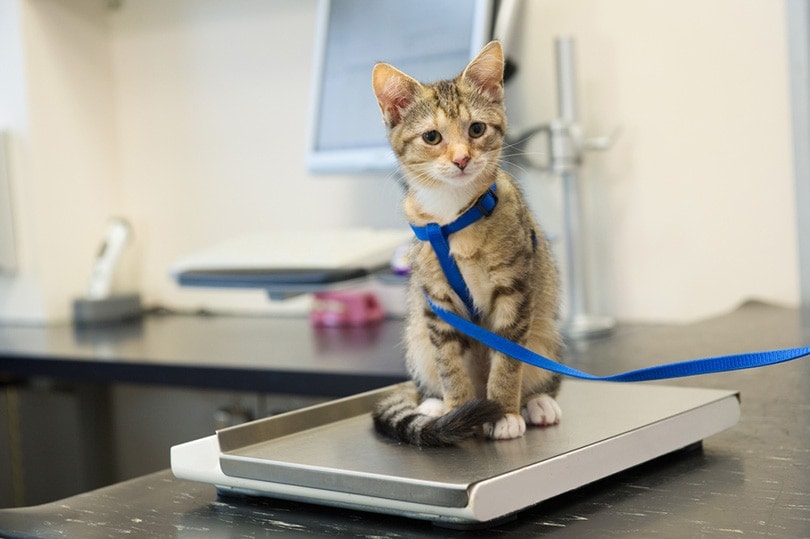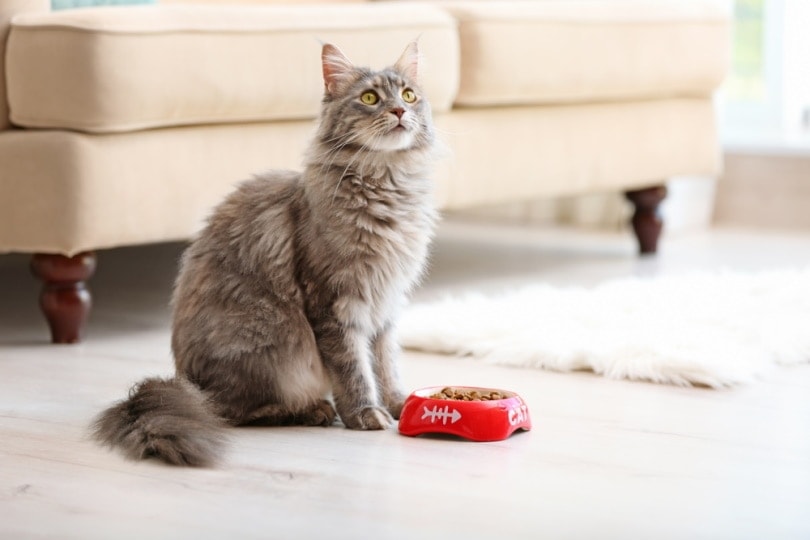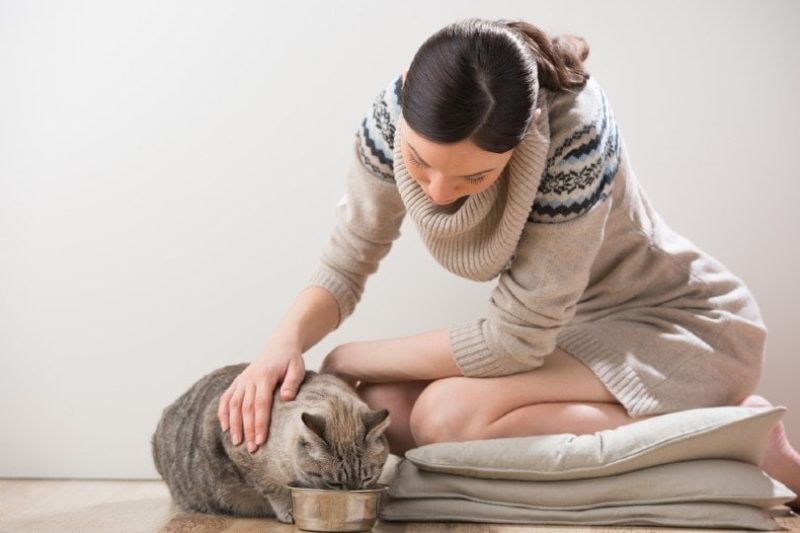How Much Should I Feed My Cat? Vet Approved Feeding Chart
By Luxifa Le
Updated on

Obesity is the number one health issue for indoor companion cats globally. Even pet parents who do their best to keep their cat’s weight under control can find themselves pulling their hair out at just how stubborn a cat can be.
Indoor cats live lazy lives, in general. They wake up and eat, take a nap, eat some more, lay in the sun, eat some more, ad infinitum. Like humans who get their food from hunting, foraging, or subsistence agriculture have fewer issues with weight than those of us who go to the supermarket, outdoor companion cats rarely have difficulty with their weight because they hunt for the food they eat. Even if cat food is available, a freshly killed rodent is often more exciting to a cat, and they’ll go out of their way to get some.
When cats don’t need to hunt for food, they’re at a massive risk of gaining weight. With that in mind, many pet parents find themselves wondering how they can help control their cats’ weights.
Feeding Chart for Adult Intact Indoor Cats (by Weight)
Important Note: The amount of calories each cat needs for healthy growth and development depends on many factors, including their age, breed, and activity level. These charts are general guidelines for healthy young cats, but we recommend confirming them with your vet.

You can calculate how much food your cat needs based on its weight. Your cat’s ideal healthy weight will determine how many calories they need a day. An adult cat requires about 25 calories per pound of body weight. However, factors such as age, sex, activity level, and reproductive state also play a role, so the exact number will change from cat to cat. This calorie calculator might help you determine your cat’s specific needs.
The exact amount of calories an individual animal needs to maintain a healthy weight is variable and influenced by many factors including genetics, age, breed, and activity level. This tool is meant to be used only as a guideline for healthy individuals and does not substitute veterinary advice
Each specific cat food has different caloric densities. You can find that information on the label, but for the sake of a general calculation, we can assume that a cup of dry food averages about 500 calories. So, if we estimate that the average ten-pound cat needs about 260 calories per day, that translates to slightly more than ½ cup of dry food per day. This is an approximation, so your cat might need more or less food depending on their activity level and the actual calorie density of their food.

Wet vs Dry Food vs Both?
Many pet parents feed their cats wet food, and some provide a mix of dry and wet food. Wet food is less dense calorically than dry food simply because of the water content. If you’re feeding a combination of wet and dry food, it is important to measure out the amounts so that your cat is getting the correct number of calories. A 3-oz can of wet food averages about 70-78 calories, depending on the brand. So, a ten-pound adult intact male will need about 3 ½ cans of wet food per day.
The trickiest part is that different foods will offer an additional number of kcals per kg. So, it is essential to check the feeding instructions on the bag to get a feel for the caloric content of the specific food that you’re feeding your cat.

40% OFF at Smalls Fresh Cat Food
Use Code Hepper24 at Checkout
Body Type and Exercise Level
It is also essential to assess your cat’s body type and exercise level. Some cats, like Maine Coons, are giant and can have a healthy body weight of up to 30 pounds. If your cat is of a huge breed, they’re going to need more food to sustain them. If your cat is very active and loves to play, it will need more food than a lazy cat and naps all day. If your cat tends to play by themselves often, consider increasing their food, especially if they’re usually hungry and begging for food.

What If My Cat Is Already Overweight?
If your cat is already overweight, it’s time to put them on a diet. Forewarning, they will hate it and likely will tell you all about how much they hate it. It will take your cat some time to get used to being on a diet. The transition period will probably require you to have a lot of patience since your cat will try everything in its power to get you to feed them. If you’re used to free-feeding your cat, you’ll have to stop doing that and start giving them set mealtimes, so they don’t overeat. While this may be more work for you overall, it will help your cat in the long run, and they’ll thank you for it. Please keep in mind that it is very important for cats to only lose weight very slowly and gradually. If a cat loses too much weight too soon, a dangerous condition called hepatic lipidosis might develop. To avoid this, please work with your veterinarian to develop a safe weight loss plan for your cat.
How to Help Your Cat Lose Weight
Cats used to being free-fed don’t generally like the transition period between free-feeding and meal-prepped-feeding. Your cat will complain and beg for food when their food bowl is empty, especially if they aren’t used to seeing it that way. One way you can get your cat to exercise more is to hide bowls of food around the house. In the wild, cats would work off the calories by hunting. Hiding small portions of food around the house can help your cat work off its calories by looking for hidden food.
If hiding food every day sounds like a chore you don’t want to add to your repertoire, consider getting a feeding toy. These toys have small holes in them, and the cats must bat the toy and roll it around to get the food out from the inside. These methods simulate hunting for your cat and allow them to work for their food much like their wild ancestors would have. If neither is doable for you, consider playing with your cat more! Chaser toys and laser pointers are a great way to get your cat moving. You can even get automatic laser pointer toys that you can set up to help your cat exercise even when you’re away. But just like people, most cats would prefer some quality playtime with their humans over a robotic toy.
While providing our feline companions with high-quality food is paramount, selecting the right food and water bowl is equally important. The modern yet practical design of our Hepper NomNom Cat Bowl combines cat-catered features, like whisker-friendly shallow dishes and slight elevation, with a contemporary style aimed at protecting your floors from messy eating and drinking. The NomNom is entirely dishwasher safe and was thoughtfully created with your cat’s health and well-being in mind.

Conclusion
How to properly feed our pets is a topic that every pet parent contends with at some point. It’s hard to say no to those cute little faces when they beg for food but making sure our pets are healthy needs always to come first. While occasional treats aren’t a bad thing, we don’t want to make a habit of letting our pets overeat. Some pets can control themselves and not eat themselves to death; others need us to intervene to keep them healthy.
There is no right or wrong way to feed your pets if they are getting the proper nutrition. Even if you are providing your cat “too much” by numbers, it isn’t a problem if they aren’t gaining excess weight. If you’re worried about your cat’s health or appetite, speak with your veterinarian. They can assess your cat’s needs and make sure that everything is okay under the hood. They’ll help you craft a perfect meal plan to keep your cat in tip-top shape!
Related Reads:
- 8 Best Slow Feeder Cat Bowls: Reviews & Top Picks
- What to Feed Stray Cats (6 Options and How to Do It)
- 10 Best Pet Scales for Cats
Featured Image Credit: ANURAK PONGPATIMET, Shutterstock













